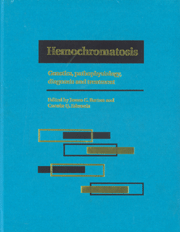Book contents
- Frontmatter
- Contents
- List of contributors
- Foreword
- Part I Introduction to hemochromatosis
- 1 A brief history of hemochromatosis
- 2 Hemochromatosis: a genetic definition
- Part II Genetics of hemochromatosis
- Part III Metal absorption and metabolism in hemochromatosis
- Part IV Diagnostic techniques for iron overload
- Part V Complications of iron overload
- Part VI Therapy of hemochromatosis and iron overload
- Part VII Infections and immunity in hemochromatosis
- Part VIII Hemochromatosis heterozygotes
- Part IX Relationship of hemochromatosis to other disorders
- Part X Animal models of hemochromatosis and iron overload
- Part XI Screening for hemochromatosis
- Part XII Hemochromatosis: societal and ethical issues
- Part XIII Final issues
- Index
1 - A brief history of hemochromatosis
from Part I - Introduction to hemochromatosis
Published online by Cambridge University Press: 05 August 2011
- Frontmatter
- Contents
- List of contributors
- Foreword
- Part I Introduction to hemochromatosis
- 1 A brief history of hemochromatosis
- 2 Hemochromatosis: a genetic definition
- Part II Genetics of hemochromatosis
- Part III Metal absorption and metabolism in hemochromatosis
- Part IV Diagnostic techniques for iron overload
- Part V Complications of iron overload
- Part VI Therapy of hemochromatosis and iron overload
- Part VII Infections and immunity in hemochromatosis
- Part VIII Hemochromatosis heterozygotes
- Part IX Relationship of hemochromatosis to other disorders
- Part X Animal models of hemochromatosis and iron overload
- Part XI Screening for hemochromatosis
- Part XII Hemochromatosis: societal and ethical issues
- Part XIII Final issues
- Index
Summary
Introduction
In 1847, Virchow reported the occurrence of golden brown granular pigmentin sites of hemorrhage and congestion; this pigment was soluble in sulfuric acid, yielded a red ash on ignition, and then produced a Prussian blue reaction. Eighteen years later, Trousseau first described the syndrome of hepatic cirrhosis, pancreatic fibrosis, and cutaneous hyperpigmentation, but he did not recognize the involvement of iron in its pathogenesis. In 1867, Perls formulated the first practical acid ferrocyanide reaction for his tologic analysis of iron, and applied the staining reaction to a variety of tissues. Trousseau's report was followed by Troisier's account of ‘diabète bronzè et cirrhose pigmentaire’ in 1871. In 1889, von Recklinghausen reported the use of the methods of Virchow and Perlsto identify excess iron in tissues obtained at autopsy of persons who had ‘hämochromatose’. Following the theories of Virchow, von Recklinghausen erroneously believed that the iron-containing pigment was derived from blood (due to hemorrhage or hemolysis), rather than from primary iron deposition, but he also described another finely granular yellow pigment that occurs with hemosiderin in the liver and other tissues in hemochromatosis that does not react to the iron methods (hemofuscin=lipofuscin). During the next several decades, additional cases were reported using variations of the terminology of the French and German physicians. In 1935, the English gerontologist Sheldon summarized 311 carefully selected ‘haemochromatosis’ cases from the literature, establishing this as the name for the disorder and for his detailed monograph.
Etiology
Sheldon concluded that the absorption of iron and possibly that of other metals is increased in hemochromatosis, suggested that the disorder is an inborn error of metabolism that primarily affects men, and rejected hypotheses that diabetes, infections, intoxication, alcoholism, and other conditions cause hemochromatosis. Clinical case series published in the interval 1935–1955 hinted that the disorder was more common than had been appreciated previously.
- Type
- Chapter
- Information
- HemochromatosisGenetics, Pathophysiology, Diagnosis and Treatment, pp. 3 - 7Publisher: Cambridge University PressPrint publication year: 2000
- 2
- Cited by



